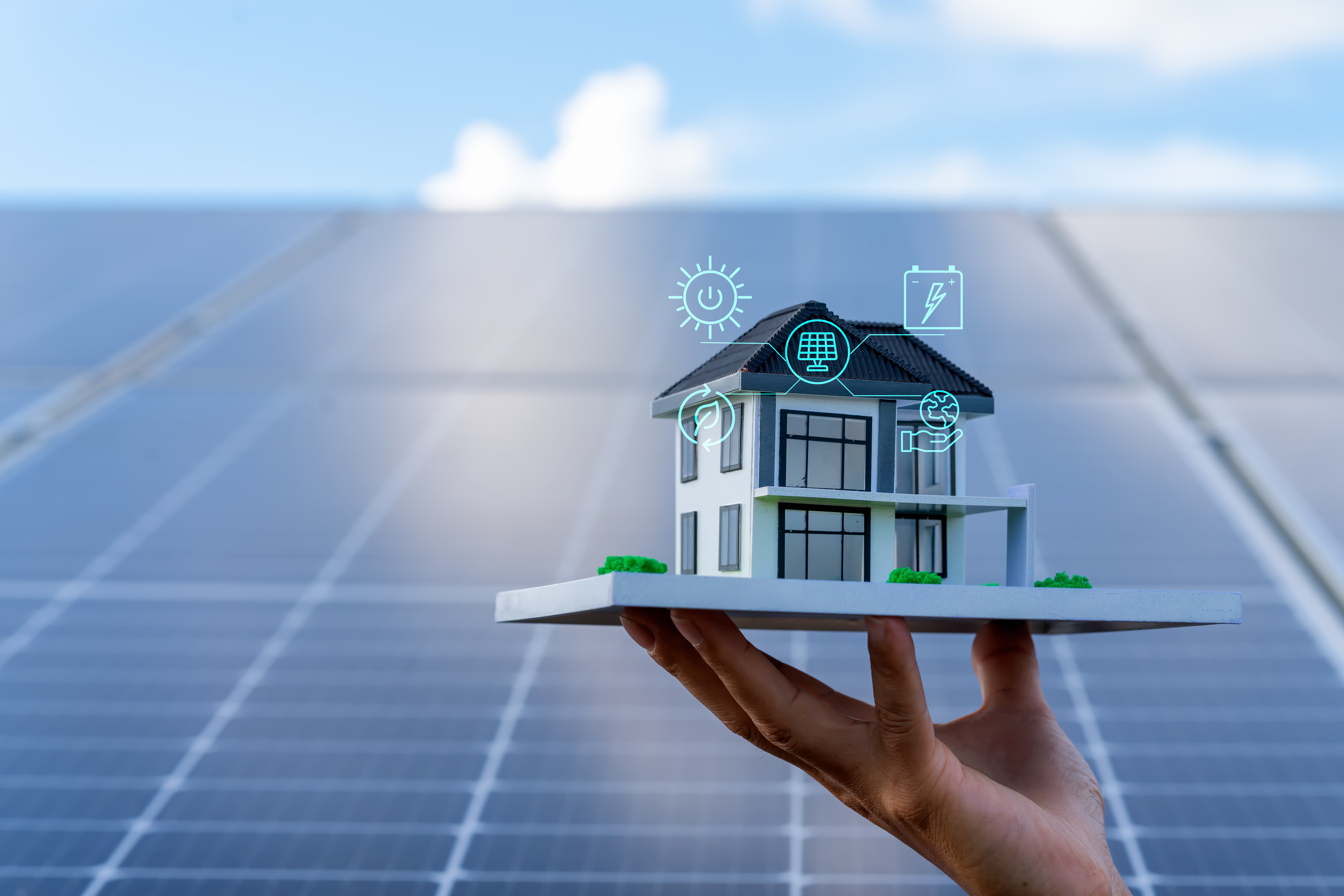Home Energy Improvements to Save Money and Go Green
Home energy improvements let you save on electricity bills while also reducing greenhouse gas emissions.


You may have heard that homeowners can use generous home energy improvement tax incentives and rebates to install solar panels or insulate their homes. Such projects often pay for themselves within a few months or years, and buyers often highly value these home features. Less well-known is the use of Home Energy Management Systems (HEMS), a relatively new technology that is quickly catching on in some areas of the country.
As the U.S. relies more on electricity and less on fossil fuels like oil or gas, the fragility of electricity grids has become more apparent. For example, the 2021 Texas deep freeze overtaxed the state-run grid, causing a blackout for 4.5 million customers and 57 deaths. Such extreme weather, inflation, geopolitical unrest and demand growth have contributed to a 30% rise in electricity prices since 2021, according to the Consumer Price Index.
The home energy management industry has stepped in to provide solutions for homeowners who want their electricity supply to be more resilient and affordable. Some of these products, such as home solar systems, are already commercially successful. But storing that energy in home batteries (for example, overnight or on rainy days) is just starting to take off. One energy management company, Scheider Electric, is rolling out connected home products that will utilize battery storage.
From just $107.88 $24.99 for Kiplinger Personal Finance
Become a smarter, better informed investor. Subscribe from just $107.88 $24.99, plus get up to 4 Special Issues

Sign up for Kiplinger’s Free Newsletters
Profit and prosper with the best of expert advice on investing, taxes, retirement, personal finance and more - straight to your e-mail.
Profit and prosper with the best of expert advice - straight to your e-mail.
The work done by Schneider Electric revolves around digitizing, electrifying and decarbonizing home energy. I spoke to Michael Lotfy Gierges, executive vice president of Schneider Electric’s Home & Distribution segment, to learn more about how energy improvements to your home, particularly the role of smart home technology — such as a home energy management system (HEMS) — can benefit both your wallet and the environment.
Home energy technology
Gierges touches on the three main challenges facing consumers in their daily lives that Schneider aims to address: the climate crisis, the significant increase in energy prices and the impact this has on the consumer.
“[The] climate crisis is real. It affects the pattern of our daily lives. It also affects the reliability and stability of the grid,” says Gierges, adding that energy prices are at a record high. "What does it mean for the daily homeowner user, whether it's your owner or a tenant? It means that you have unreliable power. You have a very expensive source of energy.”
The climate crisis is severely affecting our way of life. From extreme cold to heatwaves and wildfires, higher energy consumption and more expensive utility bills are the result. According to a study from Bank of America, the average total utility payments per customer was nearly $300 as of March 2024, a nearly one-quarter rise in cost since 2019.
Furthermore, according to Gierges, homes represent 22% of all global greenhouse gas emissions, with all buildings representing around 40% of emissions. And these greenhouse gases are one of the main causes of the climate crisis.
“This is where Schneider and my business comes into play because we can help you solve all those three challenges,” says Gierges. “Imagine [that] you live in a home where you have a prosumer (a mix between a producer and a consumer). . . . You have your energy, your solar panel on top of your home, you have a battery and an inverter, and you are driving an electrical vehicle. You have our final distribution and our home energy management system running all this for you.”
Such energy management helps you understand your overall energy consumption and be more intentional with how you use energy, which can significantly lower your energy bills. It lets you know the best time to charge your car, for example, or the best temperature to set your heater or cooler. And all this can be controlled within an app. You can click on, say, "reduce my bill" or "use more sustainable energy sources," and it will be done for you. In this way, a home energy management system can keep your home comfortable while helping manage your production and consumption of energy sustainably.
Home energy and sustainability
In addition to Schneider, companies providing home energy management systems include Generac and Tesla. As the price of residential battery storage declines, these systems will enjoy greater uptake. For now, they are most popular in states with extreme weather or high electricity prices, particularly in California, Texas and Florida. California has an incentive program through 2024. Texas and Florida do not have state-level incentives, but some utilities offer extra benefits to customers who install solar systems with battery storage.
These systems may save you money and are guaranteed to reduce greenhouse gas emissions. The less energy you use, the less emissions you’re producing. Here are several other home changes you can make, according to the EPA, to reduce greenhouse gases and save money.
- Change your lights: By replacing your five most frequently used light fixtures or bulbs with ENERGY STAR lightbulbs, you can save up to $70 a year on energy bills, as these bulbs generate 75% less heat, use about 75% less energy and last from 10 to 50 times longer.
- Purchase ENERGY Star appliances: These appliances can reduce greenhouse gas emissions by around 130,000 pounds, saving you $11,000 on energy bills.
- Heat and cool your home properly: Replace old equipment, change your air filters regularly and use the right thermostat settings (or use a smart thermostat) to reduce emissions and save money.
- Insulate your home: Caulk, weather stripping and insulation can be used to seal your home and keep the cold air in and the warm air out (or vice-versa).
- Use water efficiently: Change your habits and update appliances to avoid wasting water. For example, take shorter showers, turn the faucet off when brushing your teeth and only run your dishwasher when full. Fix all leaky appliances or replace them with WaterSense products.
- Compost: Both food scraps and yard waste make up 20% to 30% of what is thrown away. Instead of sending this garbage to a landfill, compost it instead.
- Calculate your carbon footprint: Using a carbon footprint calculator can help you gain a better understanding of how much greenhouse gas emissions you are causing.
Gierges tells Kiplinger that cost savings go hand-in-hand with decarbonization. Whatever reason you choose, “you still come to the same solution and you still come to the same result. You call it sustainability, you call it savings, you call it energy independence. It's still all the same, right? You want energy independence. You want to save money for the average consumer and the average citizen. Then sustainability is also the solution.”
Also, check out Kiplinger's list of home energy savings articles for additional ways you can save:
- Save Big by Going Green at Home
- Electric Heaters vs Radiators
- Electric vs Gas Heat: Which Is Cheaper?
- Fan Heaters vs Oil Heaters
- Dishwasher vs Hand Washing
Related Content
Profit and prosper with the best of Kiplinger's advice on investing, taxes, retirement, personal finance and much more. Delivered daily. Enter your email in the box and click Sign Me Up.

Erin pairs personal experience with research and is passionate about sharing personal finance advice with others. Previously, she was a freelancer focusing on the credit card side of finance, but has branched out since then to cover other aspects of personal finance. Erin is well-versed in traditional media with reporting, interviewing and research, as well as using graphic design and video and audio storytelling to share with her readers.
-
 Stocks Slip to Start Fed Week: Stock Market Today
Stocks Slip to Start Fed Week: Stock Market TodayWhile a rate cut is widely expected this week, uncertainty is building around the Fed's future plans for monetary policy.
-
 December Fed Meeting: Live Updates and Commentary
December Fed Meeting: Live Updates and CommentaryThe December Fed meeting is one of the last key economic events of 2025, with Wall Street closely watching what Chair Powell & Co. will do about interest rates.
-
 This Is Why Investors Shouldn't Romanticize Bitcoin
This Is Why Investors Shouldn't Romanticize BitcoinInvestors should treat bitcoin as the high-risk asset it is. A look at the data indicates a small portfolio allocation for most investors would be the safest.